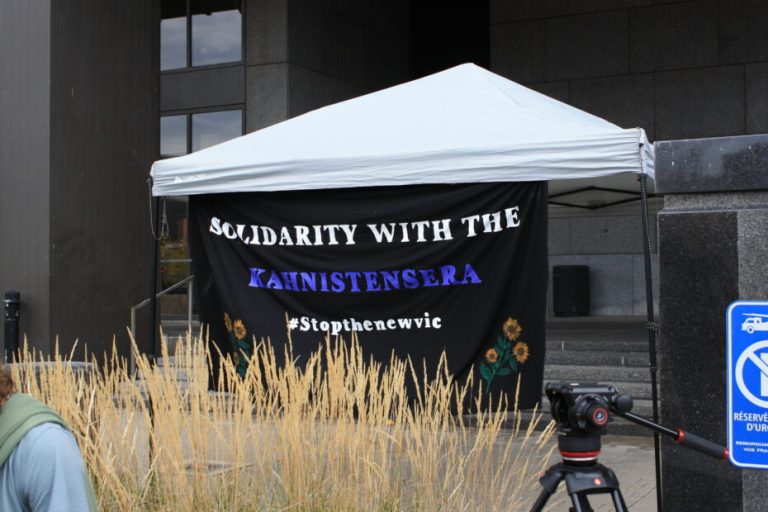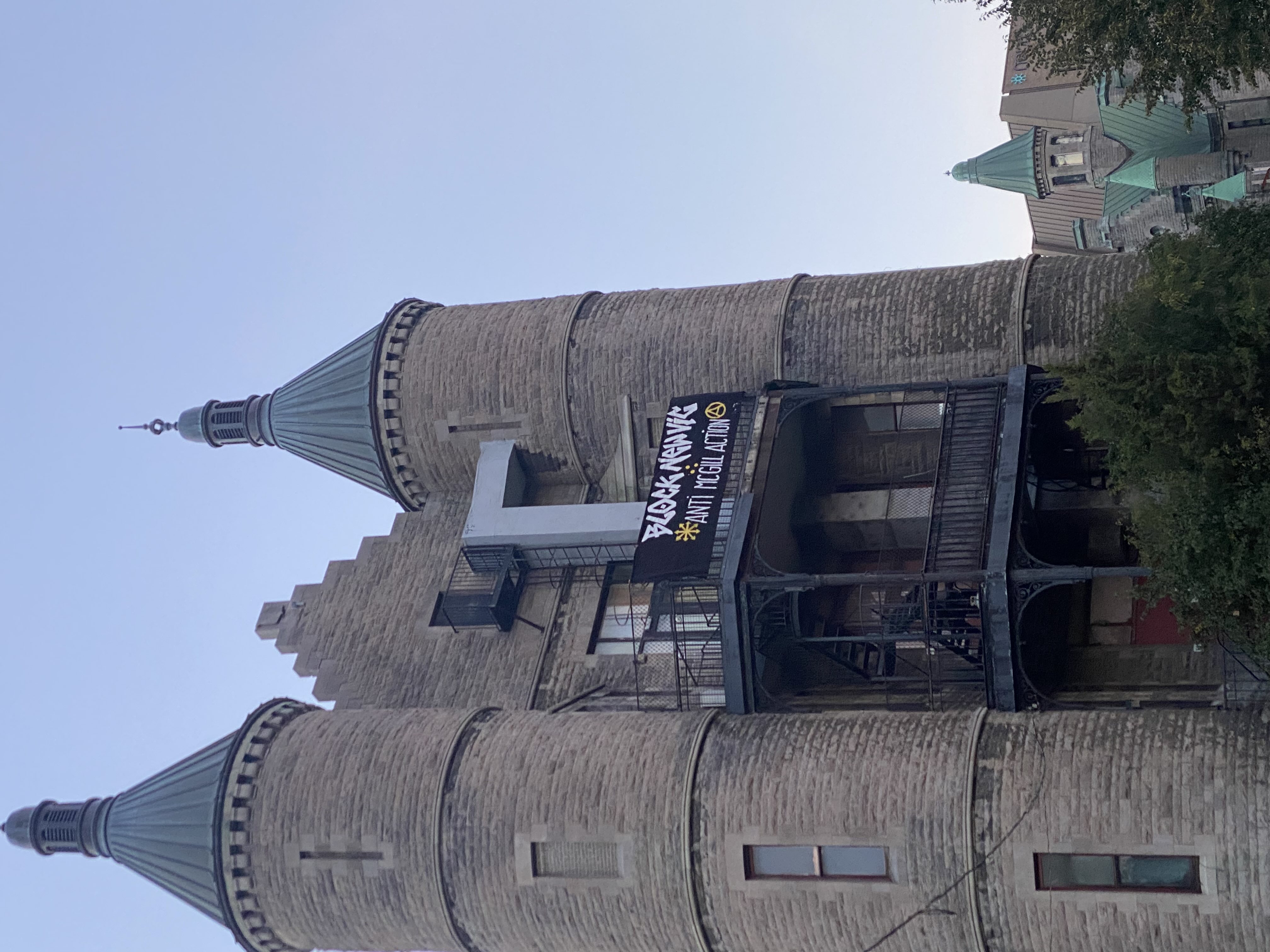Indigenous Struggles / Luttes autochtones
Retour sur le projet de barrage hydro-électrique de la Romaine
Retour sur le projet de barrage hydro-électrique de la Romaine
«Énergie propre, renouvelable, fiable et abondante» sont les premiers descriptifs du projet sur la rivière Romaine que publie Hydro-Québec. Sommes-nous étonnés? Non, car à première vue, cette société d’État québécoise présente fièrement ce projet sur leur site, dans une vidéo glorieuse, défilant quelques faits sur le barrage. Elle exprime entre autres que la réalisation du projet se fait en collaboration avec les collectivités locales, que la construction crée plus de 1000 emplois dont 45% des travailleurs sont locaux et que l’empreinte environnementale est réduite.
Journal Article Coup de hache! (2022)
Reportback from the solidarity struggle with the kahnistensera against McGill's New Vic project
Reportback from the solidarity struggle with the kahnistensera against McGill's New Vic project

Through this solidarity struggle, it has become clear that as a radical community, we need to stand in solidarity with the kanien'kehá:ka kahnistensera.
Because these traditionalist activists from Kahnawa:ke have been fighting for the last fifty years for the sovereignty of their people.
Stop the New Vic Renovation!
Stop the New Vic Renovation!
A message from CLAC-allies. 
Respect Kanien'kehà:ka sovereignty, support the search for unmarked graves
Follow our Twitter @stopthenewvic to find out how you can provide on the ground support
Anticapitalist Mayday '22: Colonial and Ecocidal, Capitalism is war!
Anticapitalist Mayday '22: Colonial and Ecocidal, Capitalism is war!

Event Manifestations
Demonstration in Solidarity wit the Wet'suwet'en: The Demonstrators Fool the Police
Demonstration in Solidarity wit the Wet'suwet'en: The Demonstrators Fool the Police

Solidarity Protest with the Wet'suwet'en #AllOutForWedzinKwa
Solidarity Protest with the Wet'suwet'en #AllOutForWedzinKwa

On November 27th, at 2PM, at the corner of Dorchester/Greene (Atwater metro), the Convergence des luttes anticapitalistes (CLAC) is calling for a demonstration in solidarity with the Wet'suwet'en people of British Columbia, who are fighting the canadian colonial state.
Kanien’kehà:ka kahnistensera vs. The Colonial State & University
Kanien’kehà:ka kahnistensera vs. The Colonial State & University
A group of Kanien’kehá:ka kahnistensera (Mohawk Mothers) went to federal court against McGill University, the Ville de Montréal, the Quebec Government, and Stantec, on Jan. 14. The group is seeking an order to halt construction of the New Vic Project until a Mohawk-led investigation into potential unmarked graves on the previous Royal Victoria Hospital site is conducted. The kahnistensera suspect that there may be unmarked graves of Indigenous children on the site, after it came to light that Dr.
MYTHS AND REALITIES ABOUT INDIGENOUS AND ENVIRONMENTAL STRUGGLES
MYTHS AND REALITIES ABOUT INDIGENOUS AND ENVIRONMENTAL STRUGGLES
People who oppose the Wet’suwet’s struggle often bring back the same opinions, which do not always reflect reality. The purpose of this article is to provide a rationale for addressing these opinions.
WHO WILL BENEFIT FROM COASTAL GASLINK?
WHO WILL BENEFIT FROM COASTAL GASLINK?
The royal Bank of Canada is at the head of a group of 27 banks who lend the 6.8 billions that are needed for the construction of Coastal Gaslink.. In Canada, the banks taking part in the agreement are ATB Financial, Bank of Montreal, Scotia Bank, CIBC, the Canadian Western Bank, Export Developpement Canada, the National bank and the Toronto Dominion. In short, the whole banking sector is supporting pipelines.
THE WET’SUWET’EN STRUGGLE FOR SELF-DETERMINATION
THE WET’SUWET’EN STRUGGLE FOR SELF-DETERMINATION
The struggle for self-determination of the Wetsu’wet’en people is not a new one. Since the late 1990s, the hereditary chiefs of the Wet’suwet’en and Gitxsan peoples have been waging a legal and political battle for recognition of their territorial rights. In 1997, these two peoples obtained recognition from the colonial legal system that their territory had never been ceded, and that their hereditary system of governance had never been extinguished.
COLONIAL EXTRACTIVISM AND INDIGENOUS RESISTANCE
COLONIAL EXTRACTIVISM AND INDIGENOUS RESISTANCE
The spring of 2020 saw one of the largest Indigenous mobilizations since the Kanehsatà:ke resistance in 1990. The Wet’suwet’en nation’s opposition to the Coastal GasLink project currently being built on their territory has inspired many other communities, both Indigenous and non- Indigenous, to take direct action across Canada, thereby blocking the national rail system, the backbone of Canadian colonial capitalism.
THE FIGHT FOR ADA’ITSX (FAIRY CREEK)
THE FIGHT FOR ADA’ITSX (FAIRY CREEK)
The area known as Ada’itsx, better known as Fairy Creek, is located near the southwest coast of Vancouver Island, about a two-hour drive from Victoria. Originally composed of the watershed of the creek of the same name, the area has come to encompass a collection of pristine forests in the region. The originally defended watershed is in Pacheedaht territory, but the area now touches a larger forest complex, including Ditidaht territory [1]
Non à la relance destructrice: ateliers de réflexion sur le développement capitaliste et colonial
Non à la relance destructrice: ateliers de réflexion sur le développement capitaliste et colonial
 Les ateliers se tiendront un samedi sur deux, a partir de la mi-juillet, à 19h dans la cour du DIRA (2035 Saint-Laurent):
17 juillet : Historique du rôle des infrastructures de transport et de communication dans le projet capitaliste colonial québécois
31 juillet : Réaménagement du territoire en cours et à venir : la stratégie maritime du Québec
14 aout : Résistances à la réorganisation urbaine, stratégies et pratiques
Les ateliers se tiendront un samedi sur deux, a partir de la mi-juillet, à 19h dans la cour du DIRA (2035 Saint-Laurent):
17 juillet : Historique du rôle des infrastructures de transport et de communication dans le projet capitaliste colonial québécois
31 juillet : Réaménagement du territoire en cours et à venir : la stratégie maritime du Québec
14 aout : Résistances à la réorganisation urbaine, stratégies et pratiques
Event Teach-ins/Conférences
Unconditional Support To Kanehsata:ke Resistance
Unconditional Support To Kanehsata:ke Resistance
Last Fall, Al Harrington and other people from Kanehsatà:ke did a fifteen day hunger strike to denounce the theft of their land by a real estate developer.
1. Historical context
In this area, and since the XVIIIth century, Mohawks continue to claim their ancestral rights on their land. Land which was at the heart of the Oka Crisis. In the 1960s, a golf course was built on part of this claimed land. Important detail: a Mohawk cemetery is located there.
